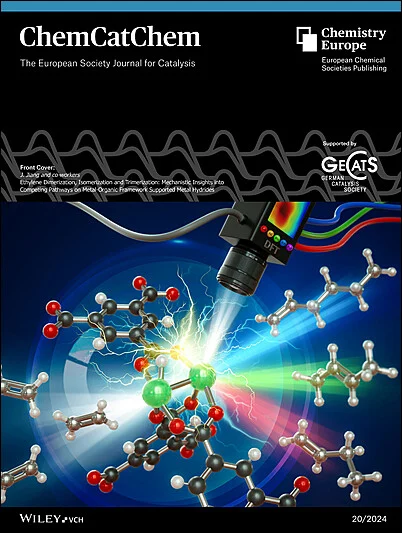Optimization and reaction kinetics of catalytic transfer hydrogenation of 5‐hydroxymethylfurfural to 2, 5‐dimethylfuran over CuCoOx catalysts
IF 3.8
3区 化学
Q2 CHEMISTRY, PHYSICAL
引用次数: 0
Abstract
From the perspective of reaction kinetics, the catalytic transfer hydrogenation (CTH) reaction of 5‐hydroxymethylfurfural (HMF) was studied in this work. Its hydrogenation product, 2,5‐dimethylfuran (DMF), was a stable and water‐insoluble biofuel alternative to gasoline. In this study, CuCoOx catalysts were used and 2‐propanol (IPA) was the hydrogen donor. The results exhibited that the HMF conversion reached 100% with the complete formation of DMF at 170 °C. Experimental and characterization results revealed that the balance of metal sites and acid sites was critical, which could inhibit the side reactions and enhance the yield of the target product. By adopting the Langmuir‐Hinshelwood‐Hougen‐Watson (LHHW) kinetic model, it was found that direct hydrogen transfer from IPA to HMF predominated over indirect transfer via H2. Moreover, the results revealed that the hydrogenolysis of BHMF to MFA was the rate‐limiting step. The kinetic study in this work is expected to provide valuable insights into the industrial optimization of the CTH reaction of HMF and lay the foundation for the study of hydrogen transfer pathways in this process.CuCoOx 催化剂催化 5-羟甲基糠醛转移加氢制 2,5-二甲基呋喃的优化和反应动力学
从反应动力学的角度,研究了 5-羟甲基糠醛(HMF)的催化转移加氢(CTH)反应。其加氢产物 2,5-二甲基呋喃(DMF)是一种稳定且不溶于水的生物燃料,可替代汽油。本研究采用 CuCoOx 催化剂,以 2-丙醇(IPA)为氢供体。结果表明,在 170 °C 时,HMF 转化率达到 100%,并完全生成 DMF。实验和表征结果表明,金属位点和酸性位点的平衡至关重要,可抑制副反应并提高目标产物的产率。通过采用 Langmuir-Hinshelwood-Hougen-Watson(LHHW)动力学模型,发现从 IPA 到 HMF 的直接氢转移比通过 H2 的间接转移占优势。此外,研究结果表明,BHMF 向 MFA 的氢解是限速步骤。这项工作中的动力学研究有望为 HMF 的 CTH 反应的工业优化提供有价值的见解,并为研究该过程中的氢转移途径奠定基础。
本文章由计算机程序翻译,如有差异,请以英文原文为准。
求助全文
约1分钟内获得全文
求助全文
来源期刊

ChemCatChem
化学-物理化学
CiteScore
8.10
自引率
4.40%
发文量
511
审稿时长
1.3 months
期刊介绍:
With an impact factor of 4.495 (2018), ChemCatChem is one of the premier journals in the field of catalysis. The journal provides primary research papers and critical secondary information on heterogeneous, homogeneous and bio- and nanocatalysis. The journal is well placed to strengthen cross-communication within between these communities. Its authors and readers come from academia, the chemical industry, and government laboratories across the world. It is published on behalf of Chemistry Europe, an association of 16 European chemical societies, and is supported by the German Catalysis Society.
 求助内容:
求助内容: 应助结果提醒方式:
应助结果提醒方式:


